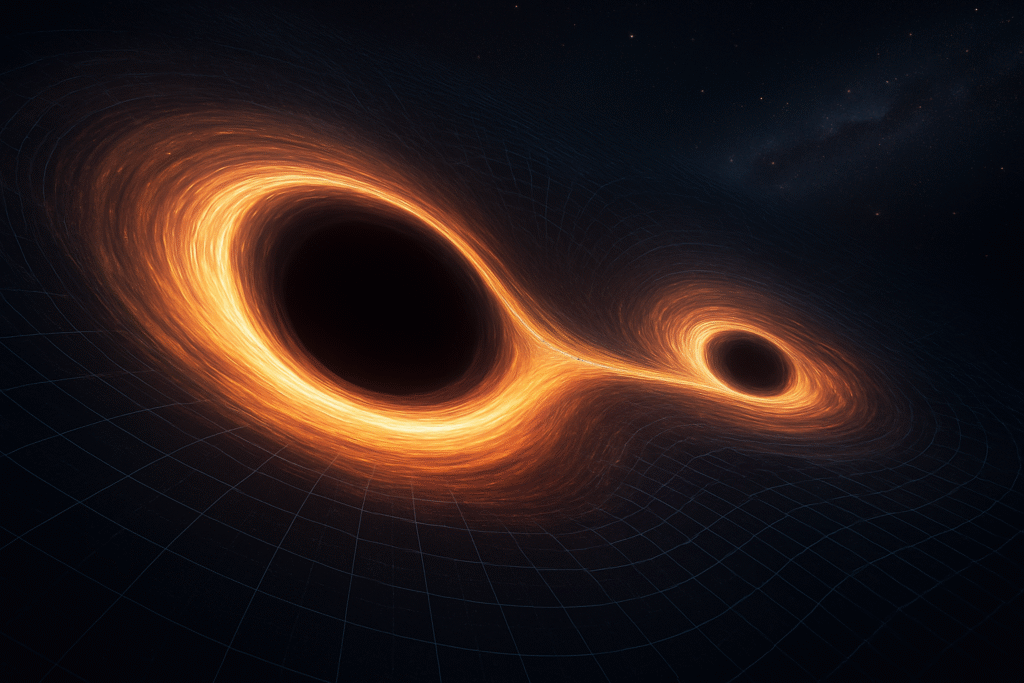Twin Black Hole Collisions Push Einstein’s Gravity to the Limit
Introduction
In late 2024, two monumental cosmic collisions occurred in quick succession. These weren’t just spectacular fireworks in the universe — they offered an unprecedented laboratory to test nature’s most fundamental laws. For the first time, we observed twin black-hole mergers (designated GW241011 and GW241110) with such precision that we can now challenge how gravity behaves under the most extreme conditions.
This article walks you through what these events reveal, why they matter for Einstein’s theory, and how they open windows to new physics.
1. The Events at a Glance
GW241011 (11 Oct 2024) happened about 700 million light years away, merging two black holes of ~20 and ~6 solar masses. The larger was one of the fastest-spinning black holes ever observed.
GW241110 (10 Nov 2024) occurred ~2.4 billion light years away, merging black holes of ~17 and ~8 solar masses. In that event, the primary black hole spun in the opposite direction of its orbit — never before seen.
These twin events offer not only cosmic drama but meaningful science.

2. Why These Collisions Are Unusual
What makes these events stand out:
Unequal masses: The two black holes have very different masses (≈20/6 and 17/8 M☉) — rare in binary mergers.
Extreme spin & misalignment: The heavier black holes spin extremely fast and have axes tilted far off the orbital plane — contradictions to typical stellar-binary origin models.
Second-generation black holes: The evidence points to these being “second-generation” — black holes formed from previous mergers, then merged again — changing how we see black-hole populations.
These exotic features turn the collisions into more than astrophysical events — they become tests of gravity itself.
3. Testing Einstein’s General Relativity
Albert Einstein’s general relativity (GR) predicts how mass, energy and spin warp spacetime. Binary black holes provide one of the few places where theory meets pure extreme physics.
On GW241011, researchers detected “higher harmonics” in gravitational-wave signals (analogous to overtones in music) caused by deformation due to rapid spin. That directly confirms GR’s prediction of how rotating black holes behave.
The observed “ringdown” and waveforms matched the Kerr metric (spinning black-hole solution) with unprecedented accuracy.
These outcomes mark the most extreme successful tests of GR to date — confirming that even under wild conditions, Einstein’s equations hold.
4. New Frontiers: From Exotic Spins to Particle Physics
Beyond verifying GR, these collisions hint at “new physics”:
Rapidly rotating black holes could lose energy to ultralight bosons — hypothetical particles beyond the Standard Model. If such bosons existed, they would extract spin energy, slowing the black holes down. The fact that these heavy black holes remain spinning rapidly effectively rules out a broad range of possible boson masses.
The misalignments and unusual spins suggest novel formation channels — such as dense star-cluster dynamics, hierarchical mergers, or environments beyond standard stellar collapse models.
These findings therefore prepare the ground for linking astrophysics, gravitational-wave science and fundamental particle physics.

5. What’s Next for Black Hole Science & Gravity
Upcoming observation runs (LIGO-India, Cosmic Explorer, etc.) will improve sensitivity, enabling many more such extreme event detections.
Scientists expect more second-generation black-hole mergers, possibly even third-generation. These will refine our understanding of stellar death, cluster dynamics and black-hole growth.
New tests for alternative theories of gravity (beyond GR) will gain leverage as more events with exotic parameters are detected.
The multidisciplinary approach — astrophysics + particle physics + gravitational-wave astronomy — will deepen our view of the universe.
Conclusion
These twin black-hole collisions are not just cosmic spectacles — they are precision probes of the architecture of the universe. They reaffirm the genius of Einstein’s general relativity even under unimaginable extremes, while simultaneously pointing to new physics waiting in the wings. As we listen to spacetime ripple, we’re also seeing what our theories can and cannot explain next.
